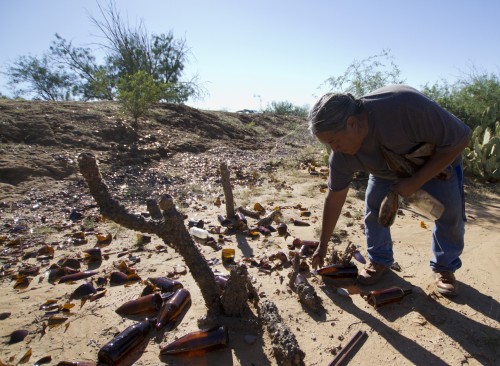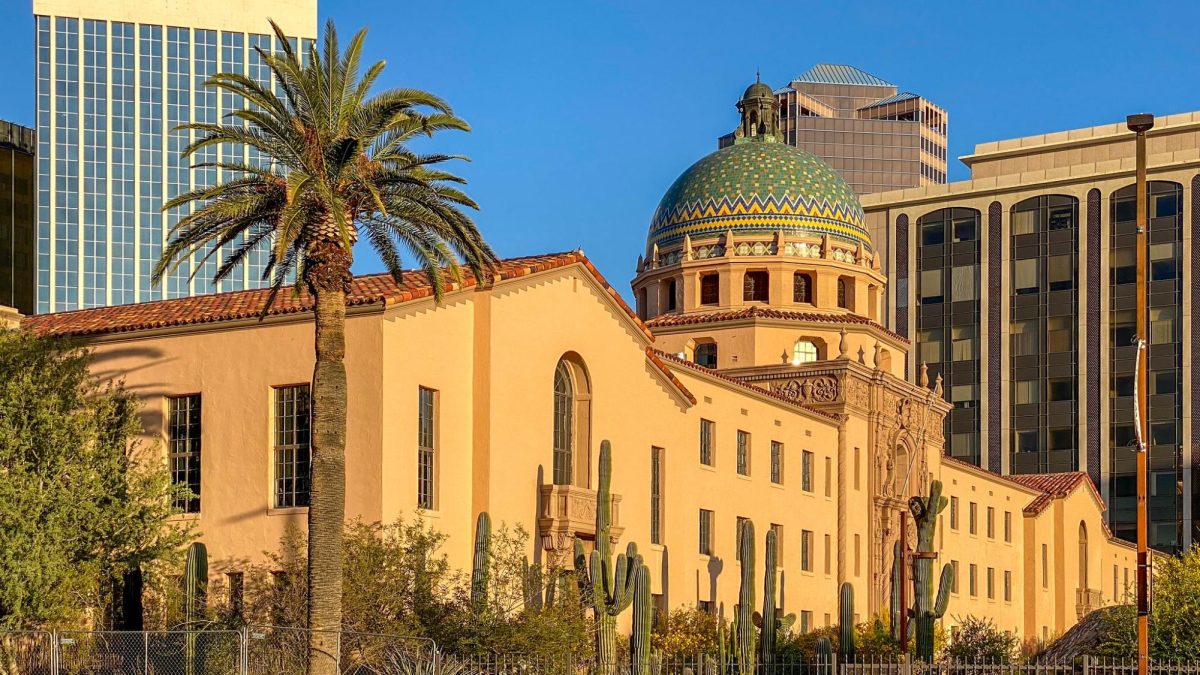Even in October, the desert southwest of Sells is a hot one.
On this clear Friday afternoon, rains from days ago have made the air cool and marginally humid, the plants lush and green. But the unforgiving sun deceives anyone standing underneath, making the 80-degree temperatures feel closer to the triple-digit threshold.
Richard Pablo bats his way through thickets of leather-leaf acacia and staghorn cholla to collect brown glass bottles dotting the landscape. Some are exposed, others lodged in the dirt with their ends peeking through the surface. The quart-sized bottles — “Qs,” as they’re called — once contained alcohol and used to go on for acres.
Arching his portly frame toward the ground, Pablo’s braided gray ponytail falls over his shoulder. He grabs one bottle and uses its neck to pry another out of the earth. One in each hand, he taps them together, mouths aimed downward, inches from the ground. Sand, moist from the rain, flows out like liquid, darker than the surface dirt that couldn’t escape the sun. He sets these bottles down and empties two more before taking all four and tossing them into a pile nearby. The clatter echoes across the desert for yards.
The work is menial and tedious, but Pablo doesn’t mind. He likes the quiet. This far away from roads, the only noise comes from the calls of a cactus wren or the infrequent chopping overhead from a Border Patrol helicopter. He likes the time it gives him to just think.
Most of all, he likes that he’s cleaning up a mess he helped make.
Pablo’s work is only part of his larger story. Pablo is at the center of two issues that plague Native American reservations in the U.S.: alcoholism and environmentalism. He serves as an assistant for a project that collects abandoned beer bottles, breaks them down and recycles them into a cement.
In doing so, Pablo feels he’s making amends to problems his drinking caused to himself, his family and his tribe.
Pablo has a tendency to ramble, and, as he works, he’s mumbling to no one in particular with a signature drawl that’s slow and steady, just like his pace in the desert. He talks about his bout with alcoholism — he’s been sober since 2010 — and he talks about what the project helped him discover.
“Who would’ve thought that one minute I’d be sitting under a tree drinking all day and the next I’d be picking up these bottles out here,” he asks with a chuckle.
His inquiry is rhetorical; he may as well be asking the bottles.
An accident in a lab
On a fall day in 2002, David Stone was mixing chemicals in a lab on the third floor of the UA’s Shantz Building. Just starting his doctoral studies in environmental sciences, Stone had a canister of 40-year-old silica powder and an idea. He planned to mix the silica with iron powder and water, hoping it would coat the iron and prevent it from rusting.
What Stone got was a mixture that hissed, steamed and spat, and eventually produced rust. But overnight, the mixture hardened.
“When I returned to the lab and realized how hard this material had become, I thought, ‘Oh, well there’s actually something perhaps useful about this,” he says.
The cement that Stone invented by accident consumed his studies. He spent months conducting experiments to explain the reaction. It became the focus of his dissertation.
Stone likens his material to the very process of rust he was originally trying to prevent — the exposure of iron to water, oxygen or acid. The red corrosive material creates a binding quality, and can make two pieces of iron adhere to one another.
Stone’s process is essentially a rusting process, but instead of exposing iron to water and air, it uses water and carbon dioxide. When combined, the two elements create carbonic acid — seltzer water.
Every type of cement needs an aggregate, or, as Stone puts it, “the chunky stuff put in concrete.” Portland cement — used on sidewalks and driveways across the globe — uses gravel, sand or rocks. Stone’s uses crushed glass.
With all the ingredients mixed together, the end product becomes a paste with a brownish-red tint like the bottles. Once it’s hardened, the specks of glass shimmer in sunlight. A brick of the material, sitting 16 inches long, 8 inches wide and 4 inches tall, sits like an unwieldy paperweight on Stone’s cluttered desk at his office on Tohono O’odham Community College’s West Campus outside Sells.
Stone’s material is strong, too. As a civil engineering doctoral candidate at Arizona State University, Sumanta Das put Stone’s material to use in another dissertation. Das’s tests found Stone’s iron-based cement to be twice as strong as Portland cement.
After graduation, Stone moved to Washington state in 2007, where he worked for three years as an environmental consultant. He used his material to build a greenhouse. He eventually grew tired of the cold and moved back to Tucson in 2011.
A fundraising event for TOCC in Tubac brought him to Jane Latané, the college’s then-interim president. She suggested Stone try implementing his product in Sells under the EPA’s Tribal ecoAmbassadors Program, which allocates $75,000 each year to a project that addresses environmental solutions on a Native American reservation. Stone’s application was awarded a grant.
But the project didn’t start with a plan to address the glass in the desert. Without a recycling program in Sells, the glass would likely have to come from Tucson, administrators thought. With the money in-hand, they were prepared to send a student assistant into town, unaware of what was scattered along the back roads nearby.
‘Stacks and stacks of glass’
Stone met Pablo in the fall 2011. A student searching for extracurricular involvement, Pablo had been sent to meet with the researcher about a new glass collection project that was in the early stages.
“He seemed like a much more colorful character than most people,” Stone recalls. “He was animated — most O’odham people are quiet and reserved, but Richard was laughing a lot and he wanted to get involved.”
Stone had found his student assistant. Soon after, TOCC administrators gave Pablo money for a glass-collecting trip to Tucson.
Pablo balked at the idea. Instead, he used the cash for gas and took Stone into the desert, following a paved road only so far before turning off into the dust.
“We just went right into the desert, and there’s party sites all over,” Pablo says. “Some places we’d go and I’d show him and there’d just be stacks and stacks of glass where everybody would just throw their bottles.”
Pablo knows the sites well. At 46, alcoholism was always part of his life. Pablo started drinking regularly at age 16, and his current span of sobriety — about five years — is his longest.
He admits that school wasn’t his top priority growing up on the Nation. His hands are calloused and thick from years working construction, laying sheetrock, roofing and building tile. Twenty years ago, he ran drugs across the reservation, which led to three years in prison.
Pablo’s experience is not unlike those of many others on the Tohono O’odham Nation. Legally, the reservation remains dry. But with a square mileage nearly equal to the state of Connecticut, a dry reservation is hard to enforce. And with so many of its members interrelated, Pablo says it’s difficult to “drop a dime” on someone.
The Nation follows the trend of alcohol abuse on reservations across the state. The Arizona Department of Health Services in its 2011 report — the most recent data available — showed alcohol-induced deaths among Native Americans in Arizona were the second leading cause of death, reaching nearly 200. The top killer was accidents — a category of its own that includes all transportation accidents and firearm discharges, according to the report that was released in February.
But the Tohono O’odham don’t have the worst numbers. In 2011, only about 20 of its members died from alcohol-related causes — a number that mirrors the neighboring Pascua Yaqui Indian Reservation. The Salt River Pima-Maricopa Indian Community tops the list with about 70 alcohol-related deaths.
Pablo’s drinking came gradually. He watched his parents drink regularly and followed their example. He joined his friends and spent hours in the desert, polishing off Qs and tossing them in the dirt.
Historical trauma
What’s at the center of Pablo’s alcoholism and the high rates of alcohol abuse among Native American communities?
One UA researcher suggests a theory called historical trauma.
The theory espouses that because Native Americans were evicted from their lands, it led to a cultural disconnect that manifested dysfunctional behavior like alcoholism.
Tommy Begay, a research associate at the UA’s Department of Psychiatry, studies the effects of historical trauma among Native American communities. Begay, a member of the Navajo Nation, refers to the use of boarding schools to assimilate Native Americans during the early 20th century. The federal policy, Begay says, caused a disconnect between Native Americans and their native culture, which serves as a foundation for a person’s development.
The result, Begay explains, is a series of dysfunctional behavior that possibly leads to violence, drug use and alcoholism. As generations of people battle vices like these, many of their children pick up the habits, simply following what they think is normal.
Reconnecting Native Americans to their culture, Begay says, has been his solution to the condition.
For Pablo, the solution was collecting the bottles.
Stone didn’t expect to address an issue like alcoholism when he started coming to Sells, but it soon became evident that the glass was more than just litter. At national tribal conferences as far as Washington, D.C., Stone and Pablo presented their project to hundreds of Native Americans. Their photos of bottles blanketing the landscape struck chords with the audiences, many of whom hung their heads in shame.
“Immediately, we had to deal with all of that,” Stone says. “It wasn’t just bottles behind a store or behind a bar. Our recycling very quickly became more than just the recycling of a material, but the recycling of feelings.”
A lasting effort
There’s not much to say about the 60-mile drive from Tucson to Sells. The two-lane Arizona 86 doesn’t have many turns, and traffic in the rearview mirror soon begins to fade on a route that doesn’t see a lot of westbound travelers. Drivers don’t see a mileage sign for the town of about 2,800 until 20 miles out.
Still, as the capital of the Tohono O’odham Nation, Sells serves as the hub for the tribe’s governing body, many tribal businesses and all of the Nation’s trash.
The Waste Management facility in Sells handles 18 to 20 tons each day, brought in from across the reservation. Without a landfill in town, the waste is trucked to Los Reales Landfill in Tucson, where the company pays $32 per ton to dump at least a single truckload every day. After factoring in the transportation expense, the monthly costs amount to about $14,000 to $16,000, said Gary Olson, the facility’s manager.
“When you have such a long distance to go to a landfill for disposal, trying to divert anything you can from that truck is important,” Olson says. “So when he came forward with an idea of glass recycling on the Nation so it would never have to leave, I saw that as a win-win situation.”
Three years into the program, Olson doesn’t see any reason to stop. Now his own workers gather what’s left of glass in the desert. The facility is outfitted with a glass crusher, a shiny, John Deere-green miracle worker whose arrival meant no more shattering bottles by hand with a tamper.
The cement has been put to use in several areas, namely on a new patio addition at the Tohono O’odham Nation Cultural Center and Museum. The project covers a span 150 feet long and 22 feet wide. Stone estimates the project uses 90,000 pounds of his material. That’s 60,000 pounds of glass that didn’t end up on another truck to Tucson.
A patent for Stone’s accident is on file at the UA’s technology transfer department. In the last few months, he’s been jumping through hoops to get it signed to his name, a bureaucratic process he’s likened to “watching crabs in a bucket.”
On a drive through Sells in September, he talks about aspects of his project that haven’t come to fruition, even three years later.
“I came out here thinking I’d be building houses and buildings,” he says, sounding more disappointed than frustrated.
Red tape surrounding housing development on the Nation has meant that Stone’s plans to address the housing shortage with his cement have stalled, but he’s not giving up.
“I see their point, but do I agree? No. Do I see it as final? No,” he says. “It could happen down the line.”
The next hurdle Stone faces is funding for his program. The EPA liked it so much that they gave him grants for two more years after the first. But the agency has since chosen to move on to other possible projects.
When Pablo graduates from TOCC in May with an associate degree in liberal arts, he won’t be the first of his family to do so, but he’ll be one of few. He’s proud of his status as a student, never missing a chance to talk about the nearly 100 credits he’ll have earned. He’s got tentative plans to transfer to the UA, but he’s not sure what he’ll study.
After decades of struggle, school became Pablo’s way out, and he knows it’s his answer to avoiding a slip back into old habits, or another dead-end construction job.
“Growing up, grade school felt so constricted,” he says. “Community college really opened up my mind — it became my dope. The instructors became, I guess, my dealers.”
Pablo’s time collecting bottles has taken him farther than he expected. In the last three years, he’s been to Washington, D.C., five times to speak at conferences. Reno once. Phoenix. He still thinks it’s funny that his public speaking instructor failed him for not being able to stay on topic during presentations.
Cleaning the desert has led to a cleaner conscience. It’s been key in helping him maintain his sobriety, but he knows it’s just the beginning.
“The glass is just the icing on the cake,” Pablo says.
_______________
Kyle Mittan is a reporter for Arizona Sonora News Service. This article originally came from the Arizona Sonora News Service website.









